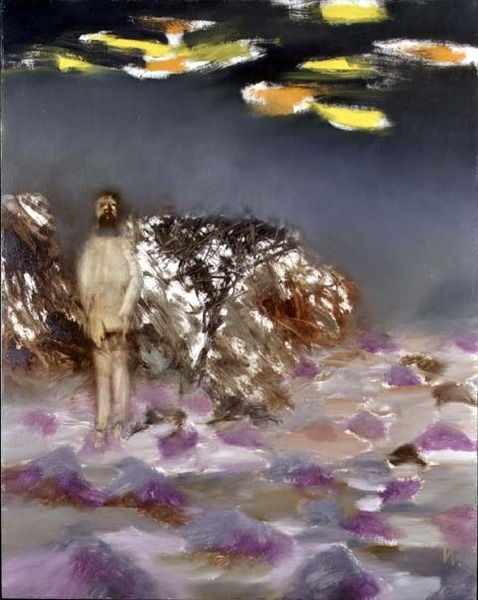

Rimbaud at Harar, 1963
Sidney Nolan, Rimbaud at Harar, 1963 (oil on hardboard), Nolan, Sidney (1917-92) / Private Collection / © Sidney Nolan Trust
Edmund George Capon AM OBE (11 June 1940 – 13 March 2019) was an art scholar specialising in Chinese art. He was director of the Art Gallery of New South Wales from 1978 to 2011.
"The precocious and unpredictable French poet Arthur Rimbaud who began writing at the age of fifteen and then abandoned literature altogether within a decade was a kindred and inspirational spirit for Sid Nolan. Nolan often spoke of how he had contemplated being a poet rather than a painter and Rimbaud remained a lifelong obsession for him. This restless soul who sought through poetry to find and express the inexpressible and who spoke of the ‘rational disordering of all the senses’ instilled in the young Nolan that pursuit of avenues of sensibility and experience which defied the predictable and the acceptable. The poet’s excessive and rebellious lifestyle, fuelled by alcohol and hashish, to get beyond good and evil, resonated with an impatient teenage Nolan who had left school at the age of fourteen. There was an indelible streak of anarchy in Nolan and Rimbaud was the perfect alter-ego; they were both ‘outsiders’ and Sidney courted that image. In an interview with Michael Heywood in London in April 1991 he said ‘oh yes I was an outsider – as a worker, a son of a worker, going to a factory at 14, I was fully conscious of being an outsider’. Nolan once said that in art ‘the screw has to be turned even further, that one has to be violent, more avant-garde, more abstract’. Such words could indeed have come from the very mouth of the young Rimbaud who, following his abandonment of poetry and literature, and indeed France, eventually ended up as a merchant and trader in Harar in Abyssinia (Ethiopia).
Thus it was that Sidney and Cynthia eventually made their pilgrimage to Africa in the autumn of 1962.
The tangible result of these travels was a series of hugely seductive and often enigmatic wildlife paintings; images of zebras, elephants, monkeys, lions, all sketchily rendered but with a strange tenderness and unusually sombre colours which imbues them with an aura of mystery. That same sense of mystery is evoked in Rimbaud at Hara with its sensitive but melancholy tones, and the haunting ghost-like image of Rimbaud who seems to blend with the undergrowth from which he uncertainly emerges rather like a figure of the risen Christ. Perhaps that was in Nolan’s mind as he pondered the life of his once mischievous hero who had turned to commerce in the unlikely and distant environment of Ethiopia.
The composition is typical Nolan; the figure of Rimbaud, naked and vulnerable, his eyes looking to the heavens, is isolated in an unlikely landscape under a darkening sky that seems to herald an uncertain world. And yet there is a silent beauty in Nolan’s almost mellifluous texture and often surprising colours; that strange ominous muddy sky, the colour of stagnant water, suddenly enlightened with flashes of yellow and red. These strange colours are echoed in his African Landscape (1963 and now in the Art Gallery of New South Wales) in which the landscape seems to be aflame with an untrammelled ferocity. Ferocious and beautiful; the outsider who in Clark’s words became ’the Australian Rimbaud’."